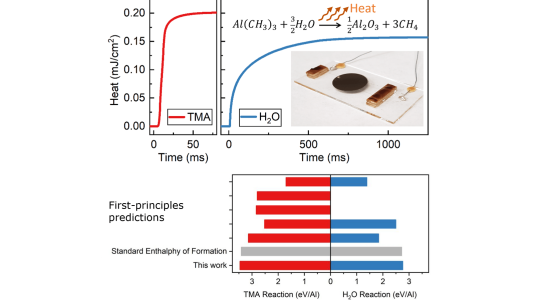
Lower: Total TMA + H₂O ALD reaction heat from this work compared with reaction heat predicted from first-principles.
Scientific Achievement
We directly measure atomic layer deposition (ALD) surface reactions through sub-millisecond time resolution of reaction heat. The study reveals a more complex mechanism for the archetypical ALD growth of aluminum oxide, a reaction that has been studied for 30+ years.
Significance and Impact
While most in situ probes measure properties of the film after each surface reaction, we interrogate the reactions in real-time at rates >100x faster than other methods and with sensitivity reaching 1/1000th of an atomic layer.
Research Details
- World-unique capability reveals 3.46 and 2.76 eV/Al heat, greater than the heat predicted by computational models based on crystalline Al2O3.
- Comparison with computational models highlights limitations to our understanding and ultimately control of even the most well-known surface synthesis reactions.
DOI: 10.1021/jacs.2c05460
Argonne National Laboratory seeks solutions to pressing national problems in science and technology. The nation’s first national laboratory, Argonne conducts leading-edge basic and applied scientific research in virtually every scientific discipline. Argonne researchers work closely with researchers from hundreds of companies, universities, and federal, state and municipal agencies to help them solve their specific problems, advance America’s scientific leadership and prepare the nation for a better future. With employees from more than 60 nations, Argonne is managed by UChicago Argonne, LLC for the U.S. Department of Energy’s Office of Science.
The U.S. Department of Energy’s Office of Science is the single largest supporter of basic research in the physical sciences in the United States and is working to address some of the most pressing challenges of our time. For more information, visit https://energy.gov/science.